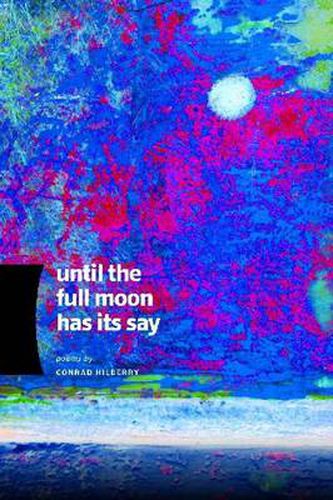Readings Newsletter
Become a Readings Member to make your shopping experience even easier.
Sign in or sign up for free!
You’re not far away from qualifying for FREE standard shipping within Australia
You’ve qualified for FREE standard shipping within Australia
The cart is loading…






The poems in Until the Full Moon Has Its Say were inspired by the loss of poet Conrad Hilberry’s wife of fifty-six years, Marion. While the poems in this volume delve into the initial emptiness and hopelessness of grieving, the poet’s connections to the natural world, music and other people ultimately bring him back into the present while still acknowledging and honouring the past. The work of a skilled poet with a lifetime of experience, this collection displays Hilberry’s mastery of form. The book’s three sections include a sonnet, five villanelles and a variety of stanza structures, all written in his signature tone, which is contemplative, tender and moving.
The elegant poems of Until the Full Moon Has Its Say arise from the consideration of ordinary, even humble, subjects - a bowl on a table, a blackout, mosquitoes, garlic mustard, algae on the local pond. Hilberry’s relaxed voice is wise and measured even in the depths of grief, as he muses, How can I draw dead branches / in a poem? Part of the answer to that question lies in the use of form, which gives shape to experience. In his formal virtuosity, Hilberry even writes a villanelle - a notoriously difficult poetic form - about writing a villanelle.
Written by the poet in his eighties, Until the Full Moon Has Its Say is a powerful reflection on mortality and on the art that has been his lifelong practise. All readers of poetry will treasure this powerful volume.
$9.00 standard shipping within Australia
FREE standard shipping within Australia for orders over $100.00
Express & International shipping calculated at checkout
The poems in Until the Full Moon Has Its Say were inspired by the loss of poet Conrad Hilberry’s wife of fifty-six years, Marion. While the poems in this volume delve into the initial emptiness and hopelessness of grieving, the poet’s connections to the natural world, music and other people ultimately bring him back into the present while still acknowledging and honouring the past. The work of a skilled poet with a lifetime of experience, this collection displays Hilberry’s mastery of form. The book’s three sections include a sonnet, five villanelles and a variety of stanza structures, all written in his signature tone, which is contemplative, tender and moving.
The elegant poems of Until the Full Moon Has Its Say arise from the consideration of ordinary, even humble, subjects - a bowl on a table, a blackout, mosquitoes, garlic mustard, algae on the local pond. Hilberry’s relaxed voice is wise and measured even in the depths of grief, as he muses, How can I draw dead branches / in a poem? Part of the answer to that question lies in the use of form, which gives shape to experience. In his formal virtuosity, Hilberry even writes a villanelle - a notoriously difficult poetic form - about writing a villanelle.
Written by the poet in his eighties, Until the Full Moon Has Its Say is a powerful reflection on mortality and on the art that has been his lifelong practise. All readers of poetry will treasure this powerful volume.